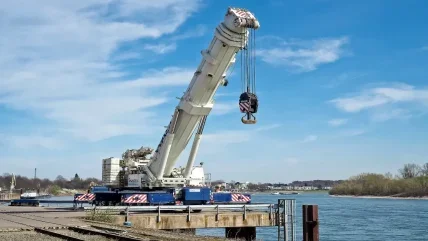
The Port of Long Beach Channel Deepening Project will go ahead thanks to President Joe Biden signing into law the Water Resources Development Act (WRDA) of 2022, the biennial legislation authorising federal flood control, navigation and ecosystem improvements.
Federal authorisation of the Channel Deepening Project allows the Army Corps of Engineers to proceed with engineering agreements, detailed planning and budgets, bidding and awarding construction contracts, and procuring funding. This year, the port and the Army Corps of Engineers are expected to execute a design agreement and initiate the design work. Construction is projected to start in 2027 and take approximately three years.
“We are grateful to members of the House and Senate and the Army Corps of Engineers who championed this bill, the many lawmakers from both parties who voted for it, and President Biden,” says Sharon Weissman, president, Board of Harbor Commissioners. “Their overwhelming support recognises how vital international trade through the Port of Long Beach is to the US economy.”
The Channel Deepening Project is one of five navigation projects nationwide that met the goals of the Army Corps of Engineers’ planning process and made the cut for construction authorisation under the new water resources law. The WRDA was packaged with the National Defense Authorization Act for fiscal year 2023.
“This project will widen and deepen the harbour serving one of the world’s top ten busiest container port complexes,” says Mario Cordero, executive director, Port of Long Beach. “Increasing the safety and efficiency of vessels transiting our waterways supports our mission to remain competitive while reducing pollution from port-related operations.”
The project has been in the works for more than eight years and is an essential component of the port’s master plan. Key elements include deepening the Long Beach Approach Channel from 76ft to 80ft, easing turning bends in the main channel to deepen a wider area to 76ft, deepening parts of the West Basin from 50ft to 55ft, constructing an approach channel and turning basin to Pier J South with a depth of 55ft, improving the breakwaters at the entrance to Pier J, and depositing dredged material in nearshore sites for reuse or in federally approved ocean disposal sites.
The project’s operational benefits include more room for the largest tankers and container vessels to transit the harbour and fewer delays related to tidal flows. Deeper, wider channels also reduce the need for large vessels to transfer liquid bulk cargo or containers to smaller vessels before entering the harbour. The process, known as lightering, ensures large vessels have the under keel clearance they need to move through the harbour as it is currently configured.
Environmental benefits include lower fuel consumption because ships will be able to manoeuvre more efficiently through the harbour. Burning less fuel reduces vessel pollution – emissions of particulate matter, nitrogen oxides and sulphur oxides.
The port is sharing the cost of the $200m project with the Army Corps of Engineers, which is responsible for building and maintaining the nation’s waterways.
Setting the stage for congressional authorisation, the Army Corps of Engineers issued a record of decision in July 2022 endorsing the project based on multi-year environmental and cost-benefit studies of project. The organisation concluded deepening and widening channels in the harbour would lead to improved vessel navigation, safety, and national economic benefits valued at more than $15m annually. In September, the Long Beach Board of Harbor Commissioners certified the project’s companion environmental impact report.
The progress built on momentum from the 2021 Bipartisan Infrastructure Law, which reflected the project’s support from the Biden-Harris administration by designating nearly $8m for early planning, engineering and design work.
California Senators Dianne Feinstein and Alex Padilla played key roles in shepherding WRDA through the legislative process, as did Representative Alan Lowenthal, who serves on the House Transportation and Infrastructure Committee. Executive director Cordero appeared before the House committee in February to discuss the global importance of the project and urge Congress to advance it.
Lowenthal is retiring after five consecutive terms representing the 47th District, which includes Long Beach, Lakewood, Signal Hill and the neighbouring Orange County communities. A former Long Beach city councilman who served in both houses of the California Legislature before winning his congressional seat, Lowenthal has advocated for the region’s economic interests and environmental protection throughout his three decades in government.


